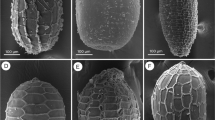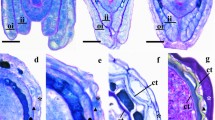Abstract
The anatomy of the seed coat of the European species of tribe Ericeae (Calluna, Daboecia and Erica) of the Ericaceae family was studied, and the taxonomic importance of their characters was analyzed. The seed coat is mostly formed by a one-cell layer with thick, pitted inner walls and thin outer walls that collapse at maturity over the inner walls. The cell junctions are either raised with anticlinal walls up to four times the height of the periclinal walls or are not raised with similar values for the height of both the anticlinal and periclinal walls. Three main cell junction types were found and described. The thickness of the inner walls is variable, but there is a large overlap among the results for different species. Calluna vulgaris is the only species with no pits, and E. multiflora has a pitted pattern on its inner walls, which is distinctive from the rest of the species. Our main results agree with the external seed morphology, and valuable new data were obtained for certain groups such as the E. cinerea-E. terminalis or the E. scoparia complex. The similarities that are found in seed coat characters are not in accordance with the classical taxonomic delimitation of infrageneric groups within Erica.






Similar content being viewed by others
References
Anderberg AA (1993) Cladistic interrelationships and major clades of the Ericales. Pl Syst Evol 184:207–231
Artopoeus A (1903) Uber den Bau und die Offnungsweise der Antheren und die Entwickelung der Samen der Erikaceen. Flora 92:309–345
Bayer EH (1993) Erica L. In: Castroviejo S, Aedo C, Gómez Campo C, Laínz M, Montserrat P, Morales R, Muñoz Garmendia F, Nieto Feliner G, Rico E, Talavera S, Villar L (eds) Flora Iberica, vol 4. CSIC, Madrid, pp 485–506
Bentham G (1839) Ericaceae In: De Candolle AP (ed) Prodromus sistematis naturalis regni vegetabilis, vol 7, pp 580–733
Brisson JD, Peterson RL (1976) A critical review of the use of scanning electron microscopy in the study of the seed coat. Scanning Electron Microsc 2:477–495
Corner EJH (1976) The seeds of dicotyledons. University Press, Cambridge
Don G (1834) A general history of the dichlamydeous plants, vol 3
Fagúndez J, Izco J (2003a) Seed morphology of Erica L. sect. Callicodon Bentham. Taxonomic implications. Pl Biosyst 137:111–116
Fagúndez J, Izco J (2003b) Seed morphology of Erica L. sect. Chlorocodon Bentham. Acta Bot Gallica 150:401–410
Fagúndez J, Izco J (2004a) Seed morphology of Erica L. sect. Tylospora Salisb. ex Bentham. Israel J Pl Sci 52:341–346
Fagúndez J, Izco J (2004b) Taxonomic value of seed characters in the Erica tetralix L. group (Ericaceae). Pl Biosyst 138:207–213
Fagúndez J, Izco J (2004c) Seed morphology of Calluna Salisb. (Ericaceae). Acta Bot Malacitana 29:215–220
Fagúndez J, Izco J (2004d) Seed morphology of Daboecia D.Don (Ericaceae). Belgian J Bot 137:188–192
Fagúndez J, Izco J (2008) Seed morphology of two distinct European species of Erica L. (Ericaceae). Acta Bot Malacitana 33:1–9
Fagúndez J, Izco J (2009a) Seed morphology of Erica L. sect. Loxomeria Salisb. ex Benth., sect. Eremocallis Salisb. ex Benth, sect. Brachycallis I. Hansen (Ericaceae) and its systematic implications. Pl Biosyst 143:328–336
Fagúndez J, Izco J (2009b) Seed morphology of the European species of Erica L. sect. Arsace Salisb. ex Benth. (Ericaceae). Acta Bot Gallica 156 (in press)
Fagúndez J, Izco J (2009c) Seed morphology and systematics of the European species of Erica L. sect. Gypsocallis Salisb. (Ericaceae) (in preparation)
Ganapathy PS, Palser BF (1964) Studies of Floral Morphology in the Ericales VII. Embryology in the Phyllodoceae. Bot Gazette 125:280–297
Greuter W, Burdet HM, Long G (1986) Med-Checklist 3. Optima, Genève
Guthrie F, Bolus H (1905) Erica L. In: Thistleton-Dyer WT (ed) Flora capensis vol 4, pp 4–315
Hansen I (1950) Die europäischen Arten der Gattung Erica L. Bot Jahrb 75:1–81
Johansen DA (1940) Plant microtechnique. McGraw-Hill, London
Juan R, Pastor J, Fernández I (1999) Morphological and anatomical studies of Linaria species from South-west Spain: seeds. Ann Bot 84:11–19
Judd WS, Kron KA (1993) Circumscription of Ericaceae (Ericales) as determined by preliminary cladistics analyses based on morphological, anatomical, and embryological features. Brittonia 45:99–114
Klotzsch JF (1838) Ericearum genera et species. Linnaea 12:211–247
Kron KA, Judd WS, Stevens PF, Crayn DM, Anderberg AA, Gadek PA, Quinn CJ, Luteyn JL (2002) Phylogenetic classification of Ericaceae: molecular and morphological evidence. Bot Rev 68:335–423
McClintock D (1989a) The heathers of Europe and adjacent areas. Bot J Linn Soc 101:279–289
McClintock D (1989b) The Erica scoparia in Madeira. The heather society yearbook, pp 32–36
McClintock D (1991) Some of the story of the Erica vagans group. The heather society yearbook, pp 27–29
McGuire AF, Kron KA (2005) Phylogenetic relationships of European and African ericas. Int J Pl Sci 166:311–318
Netolitzky F (1926) Anatomie der Angiospermen-Samen. Handbuch der Pflanzenanatomie 10. Borntraeger, Berlin
Oliver EGH (1989) The Ericoideae and the southern African heathers. Bot J Linn Soc 101:319–327
Oliver EGH (2000) Systematics of Ericeae (Ericaceae–Ericoideae): species with indehiscent and partially deshiscent fruits. Contrib Bolus Herb 19:1–483
Olson AR (1980) Seed morphology of Monotropa uniflora L. (Ericaceae). Amer J Bot 67:968–974
Palser BF, Murty YS (1967) Studies of floral morphology in the Ericales VIII. Organography and vascular anatomy in Erica. Bull Torrey Bot Club 94:243–320
Peltrisot MCN (1904) Développement et structure de la graine chez les Ericacées. J Bot 10–11:234–242, 309–367, 386–402
Salisbury RA (1802) Species of Erica. Trans Linn Soc 6:316–388
Stevens PF (1971) A classification of the Ericaceae: subfamilies and tribes. Bot J Linn Soc 64:1–53
Stevens PF (1978) Erica L. In: Davis PH (ed) Flora of Turkey, vol 6. Edinburgh University Press, Edinburgh, pp 95–97
Stevens PF, Luteyn J, Oliver EGH, Bell TL, Brown EA, Crowden RK, George AS, Jordan GJ, Ladd P, Lemson K, McLean CB, Menadue Y, Pate JS, Stace HM, Weiller CM (2004) Ericaceae In: Kubitzki K (ed) The families and genera of flowering plants, vol 6. Springer, Berlin, Heidelberg, pp 145–194
Szkudlarz P (1999) The morphological and anatomical structure of dry fruits in the family Ericaceae. Biol Bull Poznan 36:27–41
Szkudlarz P (2001) Morphological and anatomical structure of seeds in the family Ericaceae. Biol Bull Poznan 38:113–132
Szkudlarz P (2002) Morphological and anatomical structure of seeds and fruits in Phyllodoce coerulea and Loiseleuria procumbens (Ericaceae). Biol Lett 39:3–6
Szkudlarz P (2006) Taxonomy of South African ericas (Erica L.) and differentiation of their seeds. Biodivers Res Conserv 1–2:25–30
Szkudlarz P (2008) Some notes on the morphology and anatomy of seeds of two similar heathers, Erica carnea L. and Erica erigena R. Ross. Dendrobiol 59:51–55
Takahashi H (1993) Seed morphology and its systematic implications in Pyroloideae (Ericaceae). Int J Pl Sci 154:175–186
Watson L (1964) The taxonomic significance of certain anatomical observations on Ericaceae. New Phytol 63:274–280
Webb DA, Rix EM (1972) Erica L. In: Tutin TG, Heywood VH, Burges NA, Moore DM, Valentine DH, Walters SM, Webb DA (eds) Flora Europaea, vol 3. Cambridge University Press, Cambridge, pp 5–8
Werker E (1997) Seed anatomy. Encyclopedia of plant anatomy, vol 10, part 3. Gebrüder Borntraeger, Berlin, Stuttgart
Acknowledgments
The head of the Animal Physiology Department at the University of Santiago de Compostela, Joaquín Espinosa, supported this experimental study. Help was also obtained from the following researchers in different aspects of the histological techniques: Rodrigo Carbajal, Raquel Iglesias and Pablo Farinha from Santiago de Compostela University, and Carmen Acedo from León University. This study was partially supported by the Spanish government, project CGL2006-06890, Ministerio de Ciencia y Tecnología, Spain.
Author information
Authors and Affiliations
Corresponding author
Rights and permissions
About this article
Cite this article
Fagúndez, J., Juan, R., Fernández, I. et al. Systematic relevance of seed coat anatomy in the European heathers (Ericeae, Ericaceae). Plant Syst Evol 284, 65–76 (2010). https://doi.org/10.1007/s00606-009-0240-2
Received:
Accepted:
Published:
Issue Date:
DOI: https://doi.org/10.1007/s00606-009-0240-2




